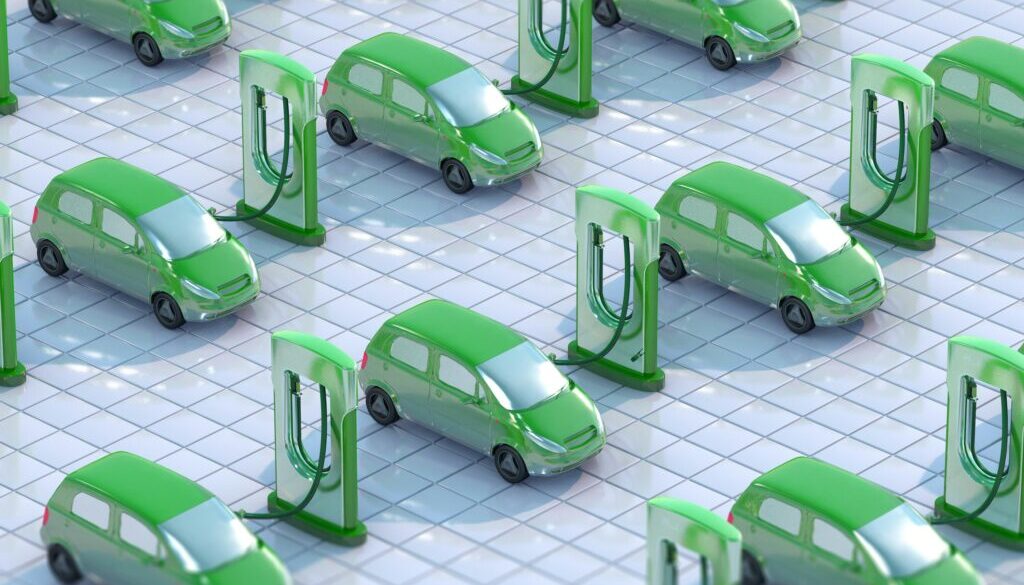Debate grows over whether some PFAS chemicals have a place in clean energy
As the planet warms at an alarming rate, culminating in the hottest summer on record, nations worldwide are rapidly scaling up so-called clean energy technologies that can replace the world’s dependence on climate change-inducing fossil fuels.
More than 100 countries last year committed to triple renewable energy capacity by 2030 to try to slow climate change and reduce the related devastating human and environmental toll from increasingly frequent and extreme weather events.
In the United States, manufacturers of electric vehicles (EVs) and EV batteries have announced more than $188 billion in investments over the last nine years, with most of the money committed during the last two. And this May, the US Department of Energy (DOE) announced a $71 million investment in projects to expand access to solar power – dubbed the “cheapest form of energy” by the DOE.
But behind the enthusiasm lies a little-discussed but looming concern. Many of these technologies being heralded as tools to turn back climate change rely on fluoropolymers, a family of plastics that are part of a class of chemicals known as per- and polyfluoroalkyl substances (PFAS). Many types of PFAS are considered so hazardous that the US and many other countries have targeted them for elimination.
PFAS have been identified as ubiquitous environmental pollutants that don’t break down naturally, with several linked to a range of human health problems. Fluoropolymer safety for humans and the environment is still a matter of debate.
But the paradox of boosting the use of potentially harmful types of PFAS chemicals in order to create technologies that can address harmful climate change is stirring debate among some experts and prompting a deeper look at the pursuit of “clean energy”.
“Obviously, the green energy transition is very important,” said Ian Cousins, a professor at the University of Stockholm in Sweden who studies the environmental impact of PFAS. “I don’t want to hinder that. But at the same time… the green industry should be not just green energy but green in every regard.”
Global production skyrocketing
In February, the US Environmental Protection Agency (EPA) proposed adding nine PFAS chemicals to a list of substances in a major waste cleanup law that are considered in assessments of hazardous waste facilities designed to protect nearby communities, while in April the agency set limits on six PFAS in drinking water. Although these regulations do not apply to fluoropolymers, an EPA rule finalized last September that requires companies to report PFAS in their products does include some of these chemicals.
Maine, Minnesota and California have passed or introduced legislation to restrict PFAS in products, and the European Union is currently weighing a proposal that would implement a sweeping ban on PFAS, although if the ban is finalized it could include exemptions for some industries.
At the same time, production of fluoropolymers used in renewable technologies is skyrocketing, with global capacity for making polyvinylidene fluoride (PVDF), a fluoropolymer widely used in lithium ion batteries for EVs, expected to more than double from its 2023 value by the end of 2032.
Environmental scientists say that fluoropolymers harm the environment at the beginning and end of their lifecycle, and that the clean energy transition will only perpetuate this problem if it relies on fluoropolymers.
Fluoropolymers have traditionally made using other types of PFAS as processing aids, particularly perfluorooctanoic acid (PFOA) and perfluorononanoic acid (PFNA), which are linked to organ damage and immune problems and pollute soil, surface and groundwater near production facilities. While many manufacturers have moved away from PFOA and PFNA, research suggests replacement processing aids made from other types of PFAS raise similar concerns.
Chemours, a spinoff of DuPont, replaced PFOA with another PFAS chemical called GenX in its process for making a popular fluoropolymer. Exposure to GenX has been linked to kidney, liver and immune problems as well as cancer, and the chemical has been found to contaminate surface and drinking water near Chemours facilities in North Carolina and the Netherlands.
Research points to particular problems with disposing of fluoropolymers. When products that contain them end up in landfills, the fluoropolymers break down into microplastics over time and leach plasticizers and toxic metals into soil and groundwater. It is unclear if they can be incinerated without emitting harmful PFAS and other toxic chemicals into the air.
But industry advocates cite industry research indicating fluoropolymers fit the criteria for ‘polymers of low concern,’ a designation used by the Organization for Economic Cooperation and Development for polymers considered not to negatively impact human health or the environment. They say these chemicals are both safe and entirely necessary for the renewable energy transition.
Some fluoropolymer manufacturers are moving towards using processing aids, known as surfactants, that are free from PFAS. They argue that fluoropolymers made without using PFAS-based fluorosurfactants “should be exempted from any regulatory initiative, and that their uses should be allowed without any unjustified restriction.”
A new PVDF facility slated to open in 2026 in Georgia that is expected to provide material for more than five million EV batteries per year at full capacity will not use fluorosurfactants in its battery-grade PVDF, according to a spokesperson for Belgium-based Syensqo, which received a $178 million DOE grant to help build the facility.
Not so benign?
PFAS have long been used in a wide range of consumer goods, including take-out containers, rain gear, frying pans and firefighting foam. Also called ‘forever chemicals’, PFAS don’t break down naturally, persisting for decades or longer in the air, water and soil. Some PFAS have been linked to cancers and other health problems, and they have been used so extensively for so long that most people around the world have PFAS traces in their blood.
Much of the concern with PFAS focuses on small-molecule chemicals, especially PFOA and perfluorooctane sulfonic acid (PFOS), which have both been linked to immune system problems, reproductive issues, and effects on the liver and other organs.
Fluorpolymers are larger, heavier molecules with applications in a range of technologies including medical devices, cell phones and laptops. They are also used in a wide variety of clean energy technologies, including solar panels, wind turbine coatings, lithium-ion batteries, electrolyzers for energy storage, and membranes for carbon capture technology.
But fluoropolymers are just as persistent as small-molecule PFAS chemicals and possibly more so, according to Rainer Lohmann, a professor of oceanography at the University of Rhode Island who directs a PFAS research program.
While fluoropolymers are not that harmful while they are in use, according to Lohmann, there is evidence that they can invade living cells. He pointed to a 2003 study that found particles of polytetrafluoroethylene (PTFE or Teflon), a fluoropolymer product, migrated to the lungs of hamsters when inhaled.
Based on emerging research on molecules similar in size to fluoropolymers, “a blanket statement that polymers cannot enter cells is factually inaccurate,” Lohmann and colleagues wrote in a 2020 analysis of how fluoropolymers impact human health and the environment.
Particularly when considering the environmental damage from their production and disposal, it is “a bit far-fetched to claim that they are so benign,“ he said.
Adding to the concerns, a 2024 study by Cousins and colleagues found that when fluoropolymers are made, “a wide array of additional fluorinated organic substances” are released into air and water. And a pre-proof study released September 11 found that when PTFE is made with hydrocarbon processing aids, “numerous” PFAS impurities were produced.
Building greener alternatives
Many in the lithium-ion battery industry maintain that these products simply can’t be made without PFAS. Chemours states on its website that fluoropolymers are “critical and irreplaceable” for EVs and other renewable energy technologies.
“PFAS are extremely useful because they do a really good job in terms of waterproofing and weatherproofing the battery itself,” said Jeffrey Dintzer, an environmental lawyer with the firm Alston & Bird. “We don’t really have alternative chemical formulations which are quite as effective.”
But others argue that industry inertia is the biggest factor holding up a move away from PFAS in lithium-ion batteries.
“The battery industry is very traditional and doesn’t like to change what’s known,” said Pierre Blanc, chief technology and industrial officer for Leclanché, a Swiss lithium-ion cell company. “If something works, the golden rule is don’t touch it.”
Leclanché is among a handful of companies that have found workarounds to PVDF lithium-ion battery cells, making use of chemicals found in hair gels and other household products and using a water-based manufacturing process.
Massachusetts-based Nanoramic Laboratories has also developed a replacement for PFAS chemicals in battery electrodes. EV batteries made with Nanoramic’s PFAS-free product will be on the market for EVs in the approximately the next five years or so, according to Christian Dietrich, the company’s director for business development.
In December, Nanoramic received a $47.5 million DOE grant to build a lithium-ion battery manufacturing plant in Bridgeport, Connecticut. GM Ventures, an arm of General Motors, has invested in Nanoramic’s technology.
Going PFAS-free would make it possible to fully recycle EV batteries, and, critically, it could save companies money, said Dietrich. “Some companies want to get ahead of PFAS regulations,” he said. “Some customers are really interested in green, sustainable products. But mainly, in the end, it comes down always to cost.”
Like EVs, the solar energy industry is heavily reliant on PFAS chemicals because of their resistance to sunlight, high temperatures and water vapor, making solar panels longer lasting.
“In traditional solar panels which have a glass front side and a polymer backside, that polymer backside in almost all cases contains PFAS,” said Gerard de Leede, co-founder of Solarge, a Dutch solar panel company that has developed solar panels made fully from non-fluorinated polymers, which are promoted as being free of toxic chemicals and fully recyclable.
“There’s growing attention to exclude PFAS,” said de Leede. “The more people are aware of this [PFAS] problem and the more restrictions and regulations come into place, we expect to grow our technology.”
In the US, the DOE’s Advanced Research Projects Agency–Energy (ARPA-E) is currently “exploring the possibility of one or more new programs that are looking at alternatives to PFAS-type products that go into energy technologies,” said ARPA-E Program Director Charles Werth.
But even as momentum slowly builds to replace PFAS in renewables in the US, the EU, and elsewhere, a key player in the industry lags behind. China currently produces more than 80% of the world’s solar panels and an almost equally high share of global EV batteries.
While in the past Chinese brands would list PFAS chemicals on their solar panel product data sheets, they have increasingly become less transparent as global PFAS concerns have escalated, according to de Leede.
“There is no local interest in China to stop using PFAS,” said de Leede. “Nobody raises questions.”
(Featured image by Unsplash+ in collaboration with Resource Database.)




